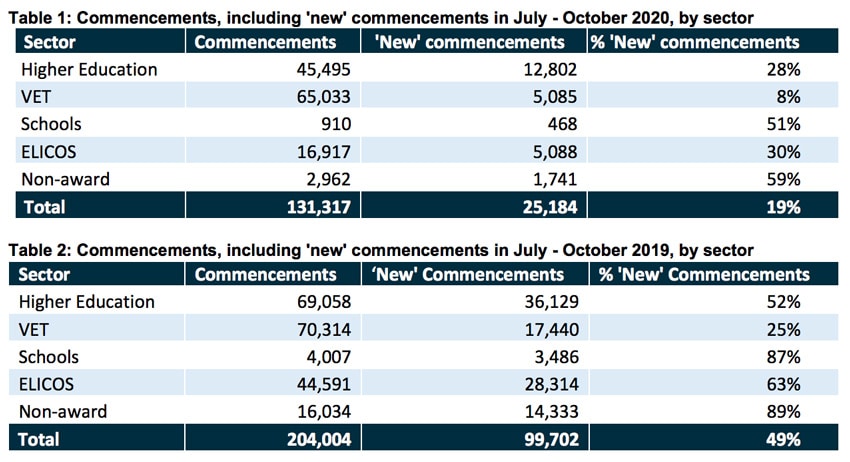A closer look at the factors shaping Australia’s international enrolment this year
- New data from the Australian government analyses the country’s international enrolment with additional detail on returning, commencing, and offshore students
- The data reveals a strong, continuing enrolment base for 2021 and identifies some of the important factors that will influence enrolment levels this year
Earlier this week, Brendan Murphy, the Secretary of Australia’s Department of Health, said that he expected that the country’s current restrictions on international arrivals were likely to remain in place for “most of 2021”. No public health officials, including Secretary Murphy, are comfortable projecting more than a few months ahead at any given moment. But his observation follows last week’s cabinet decision to further restrict international arrivals through mid-February, a move that Prime Minister Scott Morrison explained was made to "manage the flow of returning Australians and other travellers who have been potentially exposed to the new variants" of COVID-19.
The tighter restrictions, which came into force on 15 January, will see the weekly cap on international arrivals reduced from 7,500 to less than 5,000 per week through 12 February. That new, lower limit on arrivals from overseas will continue to prioritise returning Australians – of which an estimated 36,000 remain outside the country – over foreign nationals, including visiting students.
Perhaps not surprisingly, a number of previously announced student arrival pilots have not so far gone as planned. Only one, in Australia's Northern Territory, has successfully brought students to study in the region. Other pilots planned for South Australia, New South Wales, and Victoria have been suspended or delayed.
These are all developments that factor in the expectations of students and educators alike when looking ahead to upcoming intakes in 2021. Modelling for the year is well underway and newly released data from Australia's Department of Education, Skills and Employment (DESE) provides some important insights as to how the enrolment base is taking shape as we progress into the New Year.
One research snapshot focuses on returning or continuing international students enrolled in Australia as of 15 October 2020. It finds that overall enrolment in this category has declined by roughly -13% year-over-year, from 580,202 as of 15 October 2019 to just over 502,000 on the same day in 2020.
DESE observes that, "Although 2020 has been an unprecedented year in Australian international education, the resilience of our international students is apparent from this data demonstrating that substantial numbers of international students, both in and outside Australia, will return in 2021." The point being made there is that in previous years, the late-year enrolment base has been an effective indicator of international enrolments the following year.
That pattern will be less predictable this year but, while the enrolment base summarised in the following table is certainly lower than in 2019, it still suggests a strong foundation of continuing students for 2021. "There are grounds to be confident of there being at least 381,546 enrolments on 1 January 2021, if not more," concludes DESE.

2021 enrolment patterns will also be shaped in part by large volumes of deferred programme starts from 2020. DESE reports more than 97,000 deferrals for the year-to-date October 2020. Of those, roughly a third have since recommenced or completed their studies. Another third have rescheduled to upcoming intakes (the vast majority of those planning to begin or resume their studies in 2021), and the final third has not yet rescheduled their programme starts.
In-country or offshore?
Another complication for forecasting this year is that there is still a large number of currently enrolled foreign students who are studying remotely from outside of Australia. By matching enrolments to available visa data, DESE estimates that between 18%-23% of students enrolled as of 15 October were pursuing their studies from outside the country. This amounts to somewhere between 90,000 and 115,000 students offshore as of mid-October.
The following table breaks these totals down into more detail, including by sector.

Tracking commencements
DESE has also reported on commencements for the period July-October 2020 and there again we see an unsurprising drop-off year-over-year. There were just over 204,000 commencements in that same period in 2019, and that total fell by -36% in 2020, to slightly more than 131,300 – with between 22%-32% of those beginning their studies from outside of Australia.
The overall drop in commencements in 2020 is almost entirely reflected in a corresponding decline in the volume of "new" commencements reported by DESE. "New" commencements are those students with no prior enrolment in Australia, whereas other commencements include students who have studied in Australia previously and are progressing on to new programmes or new levels of study.
This suggests that commencement declines have been largely driven by the group of students with the weakest attachment to Australia – that is, those who have not yet begun their study experience in the country.

The attachment of new and prospective students to Australia will certainly figure in overall enrolment levels for this year, as will the continuing attachment of currently enrolled students who are following their Australian study programmes from outside the country.
Harking back to the question of border restrictions for this year, DESE concludes: "How student numbers will develop after 1 January 2021 is unclear at this time. It will depend on the propensity of students outside Australia to commence new courses and the pace at which international students may be able to enter Australia as the year progresses."
For additional background, please see:


















